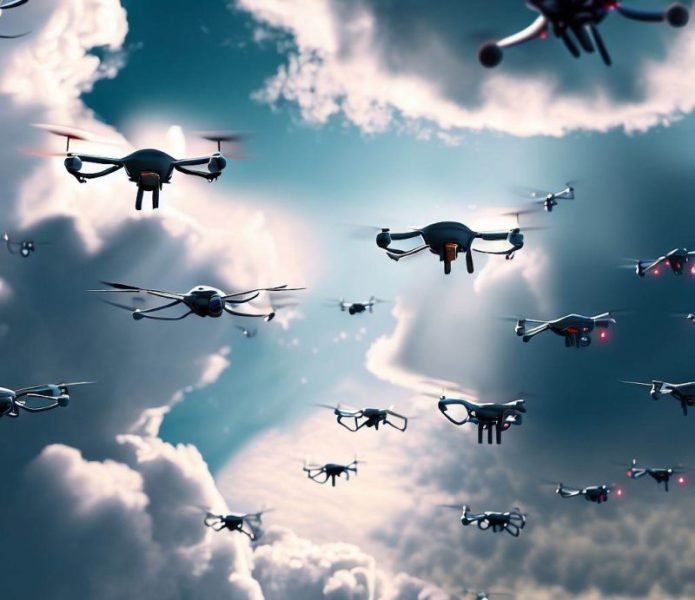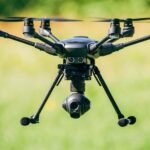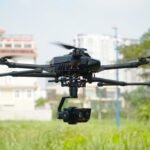Introduction
Defining Drone Swarms
Drone swarms represent a cutting-edge technological advancement that harnesses the power of multiple drones working together in unison. Imagine a flock of birds, each intuitively responding to the movements of its neighbors, creating fluid patterns in the sky. This is essentially what drone swarms do! Utilizing algorithms derived from nature and artificial intelligence (AI), these drones can perform complex tasks collaboratively. So, how do we define a drone swarm? At its core, a drone swarm consists of a coordinated group of drones that can operate together to achieve specific objectives. These objectives can range from surveillance and data collection to search and rescue operations and beyond. Here’s what makes drone swarms stand out:
- Autonomous Operation: Each drone can operate independently while communicating with others in the swarm. This means they can adapt to changing scenarios without human intervention.
- Scalability: Swarms can consist of just a few drones to thousands, easily scaling up or down to meet mission requirements.
- Redundancy: If one drone fails, others can take over its tasks, enhancing mission resilience.
For instance, universities and tech companies are developing “cooperative” algorithms that allow drones to collaborate effectively, whether they’re delivering packages or conducting scientific research. These systems are designed to optimize routes, avoiding collisions and improving efficiency.
Evolution of Aerial Technology
The story of aerial technology is a fascinating journey filled with innovation and exploration. From the Wright brothers’ first powered flight in 1903 to the adoption of drones in military operations, aerial technology has transformed dramatically. Let’s take a closer look at this evolution—it’s quite the ride!
- Early Days of Flight:
- 1900s: The dawn of aviation saw imaginative minds in the realm of flight with kites and gliders. Early experiments were not highly successful but laid the groundwork for future developments.
- 1910s-40s: The integration of aviation in warfare led to rapid advancements in technology. The development of camera-equipped aircraft during World War I allowed for reconnaissance missions.
- The Birth of Drones:
- 1950s-80s: The inception of drones began with military applications, including target drones for training purposes, allowing military personnel to practice shooting down enemy aircraft without any aircraft actually being at risk.
- 1990s: Drones became more sophisticated, initially serving as surveillance tools during conflicts. The introduction of the Predators and the Global Hawk for intelligence gathering represented significant strides.
- The Consumer Drone Revolution:
- 2000s: As technology advanced and costs decreased, drones made their way into the civilian realm. The introduction of quadcopters and simple remote-controlled drones opened up a new frontier for hobbyists and professionals alike.
- 2010s: The boom of consumer technology companies like DJI brought affordable drones to the masses, enabling everything from aerial photography to leisurely drone racing.
- The Birth of Swarms:
- Recent years: The integration of machine learning and AI has spurred the development of drone swarms. Research projects by universities and defense organizations have worked tirelessly to create collaborative systems where drones can operate together seamlessly.
Let’s consider a practical example: In 2015, a group of researchers at Harvard University successfully demonstrated a drone swarm capable of navigating through a complex environment and performing tasks like package delivery, showcasing how drones could be utilized in real-world scenarios.
Not Just Science Fiction
You might be wondering, is this technology just hype? Absolutely not! The advancements in drone technology and swarm intelligence have made it possible for swarms to be used in various sectors. Whether it’s agricultural monitoring, wildlife protection, or environmental studies, the horizons keep expanding. For instance, agriculture technicians can deploy drone swarms to monitor crop health over large areas quickly, providing invaluable data for farmers to make informed decisions. To illustrate how swarms can work in specific applications, here’s a simple table showcasing various sectors where drone swarms are making waves:
| Sector | Application |
|---|---|
| Agriculture | Crop monitoring and aerial analysis |
| Disaster Relief | Search and rescue operations |
| Environmental Monitoring | Wildlife tracking and data collection |
| Military | Reconnaissance and target acquisition |
| Event Photography | Aerial filming for large events |
In conclusion, understanding drone swarms and their technological evolution paints a picture of limitless possibilities. The synergy between several drones working together can lead to impressive results in numerous fields. As we continue this exploration into drone technology, buckle up and get ready for an exciting journey into the advantages, applications, and challenges that this transformative technology presents! 🚀
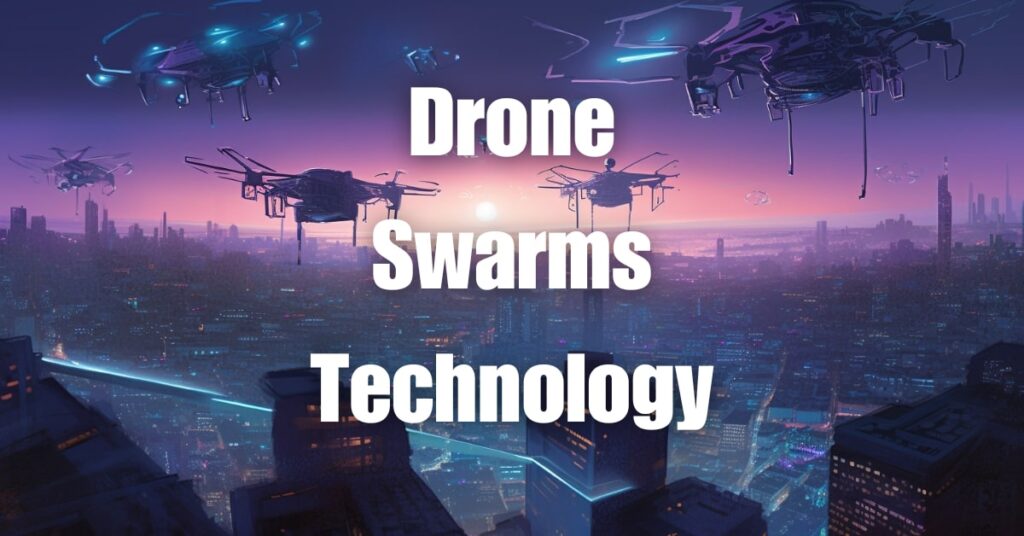
The Advantages of Drone Swarms
Enhanced Efficiency
As we delve into the world of drone swarms, one of the most compelling advantages is enhanced efficiency. Imagine a scenario where a single drone is tasked with surveying a vast agricultural field. It might take hours, if not days, to capture all the necessary data. Now, picture instead of just one drone, you have a swarm of ten or even a hundred synchronized drones working in tandem. Together, they can dramatically reduce the time needed for the same task, providing results in mere minutes. This example exemplifies the powerful efficiency gains that drone swarms can bring.
How Drone Swarms Enhance Efficiency
- Parallel Processing:
- Unlike a single drone operating sequentially, drone swarms can break up tasks and work on multiple sections simultaneously. For instance, in a search-and-rescue mission, each drone can scout a different sector, reducing the time required to cover large areas.
- Adaptive Strategies:
- Drone swarms can adapt to their environment dynamically. They can rearrange themselves based on obstacles or new information obtained in real-time, ensuring that they’re always working in the most efficient manner possible.
- Data Collection and Analysis:
- The synergy of multiple drones allows for more comprehensive data collection. A swarm can gather varied types of data such as video footage, thermal imagery, and environmental samples, all at once. An example of this could be a swarm of drones deployed in a disaster-stricken area collecting live data for first responders without the delays caused by limited resources.
- Resource Utilization:
- Drone swarms make optimal use of available resources. For example, agricultural drones can cover large areas, applying fertilizers or pesticides more accurately and efficiently than traditional methods, which often require heavier equipment.
Here’s a handy overview of some efficiency-enhancing aspects of drone swarms:
| Efficiency Aspect | Description |
|---|---|
| Parallel Processing | Multiple drones scanning different sections at once |
| Adaptive Strategies | Real-time rearrangement based on environmental changes |
| Comprehensive Data Collection | Gathering a variety of data types simultaneously |
| Optimal Resource Utilization | More precise and efficient application of resources |
Improved Safety Measures
Safety is another significant advantage of drone swarms, especially when considering their applications in high-risk environments. Whether it’s military operations, disaster relief, or industrial inspections, drone swarms offer a layer of safety that is hard to achieve with manned missions.
How Drone Swarms Enhance Safety
- Reduced Human Risk:
- In scenarios like search-and-rescue operations in hazardous areas, deploying drones instead of people can reduce the risk of injury or death. Drones can navigate dangerous terrains—like collapsed buildings or submerged vehicles—allowing them to scout areas a human would not dare to enter.
- Surveillance in Hostile Conditions:
- Swarms can be particularly useful in military applications, where they can conduct reconnaissance missions in enemy territory without risking pilots’ lives. A swarm of drones can spread out over a wide region, gathering intelligence while remaining difficult to target.
- Real-time Decision-Making:
- The algorithms used for cohesion and coordination allow drone swarms to make split-second decisions. If a swarm detects an obstacle or a change in environmental conditions, they can dynamically adjust their flight patterns, minimizing the risk of accidents.
- Automated Operations:
- With advancements in AI, drone swarms can execute missions with little to no human interference. This automation not only speeds up operations but also minimizes potential human errors. For instance, in industrial inspections of pipelines or infrastructure, drones can autonomously survey large areas while minimizing the risk of hazards that could endanger human inspectors.
Here’s a bullet-point list that highlights how drone swarms improve safety:
- Lower risk of human injury in hazardous environments.
- Enhanced surveillance capabilities for military reconnaissance without personnel exposure.
- Split-second decision-making to avoid obstacles and adjust flight patterns.
- Automation of operations reduces human error in critical tasks.
Take this into consideration: In wildfire management, drone swarms can assess fire spread and identify hotspots effectively. Their ability to operate in real-time means they can continuously update fire-fighting teams with information without putting anyone in the path of danger.
Real-World Examples
Imagine conducting inspections of tall wind turbines or bridges. Operators traditionally would need to send teams of professionals equipped with safety gear, scaffolding, and climbing equipment. This method can be time-consuming, costly, and risky. By employing drone swarms, inspections can be completed more efficiently; a swarm can circle the structure from all angles, delivering high-resolution imagery while keeping personnel safely grounded. Similarly, during the COVID-19 pandemic, some cities experimented with drone swarms to monitor compliance with social distancing measures. Drones ensured safety for the public while providing municipalities with the necessary data to guide health protocols.
Conclusion
To sum it up, the advantages of drone swarms encompass significant efficiency improvements and enhanced safety measures. As technology continues to advance, drone swarms are poised to redefine how we approach various challenges across diverse sectors. You can think of modern drone swarms as a tool that brings together the best of both worlds: working smarter and safer. The possibilities are endless, and as we continue to explore these applications, the potential for innovation will only grow! 🌟
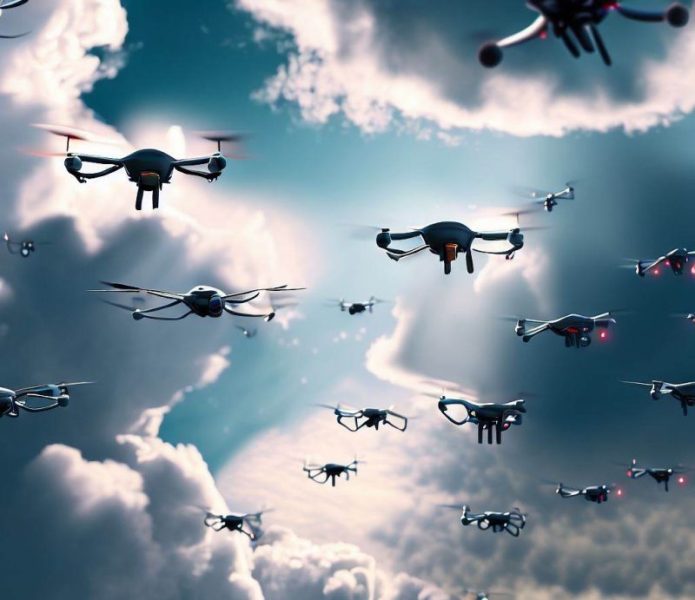
Applications of Drone Swarms
Military Uses
As we explore the remarkable applications of drone swarms, the military stands out as one of the most significant sectors benefiting from this innovative technology. The military has always been at the forefront of technological advancement, and drone swarms are no exception. Imagine numerous drones deployed during a mission, each working cooperatively to gather intelligence, conduct surveillance, or even engage in tactical operations.
How Drone Swarms Are Utilized in Military Operations
- Intelligence, Surveillance, and Reconnaissance (ISR):
- Drones have transformed traditional ISR methods. A swarm of drones can cover vast terrain simultaneously, collecting priceless data without putting personnel in harm’s way. For example, during a conflict, a military unit can deploy a swarm to monitor enemy movements while remaining concealed.
- Target Acquisition:
- Beyond reconnaissance, drone swarms can facilitate target acquisition with precision. With their ability to communicate and share information, they can effectively pinpoint enemy locations, relay that information back to operators, and allow for coordinated strikes. Think of a situation where multiple drones simultaneously scan for a target; once identified, they can collaboratively lock in on it, providing real-time data to ground forces.
- Electronic Warfare:
- Drones have also been adapted for electronic warfare. Swarms can jam enemy communications or intercept transmissions, creating a tactical advantage. This capability allows for disruption and confusion among adversaries, an essential aspect of modern warfare strategies.
- Resilience and Redundancy:
- Military operations can be unpredictable, and drone swarms provide resilience. If one drone encounters a malfunction or is destroyed, others can continue the mission, ensuring that objectives are still met. This redundancy is critical in military operations, where failure is not an option.
| Military Application | Description |
|---|---|
| Intelligence Gathering | Covering large areas simultaneously for data collection |
| Target Acquisition | Precision pinpointing of enemy locations |
| Electronic Warfare | Jamming enemy communications for tactical advantage |
| Resilience in Operations | Continuation of mission despite drone losses |
A real-world example illustrating the military applications of drone swarms occurred during various recent conflicts, where coordinated aerial fleets flew simultaneously to gather intelligence without risking human life. These advancements have reshaped military strategies, enhancing their effectiveness dramatically.
Disaster Relief Efforts
Transitioning from the battlefield to the front lines of humanitarian efforts, drone swarms are proving to be invaluable in disaster relief operations. In the aftermath of natural disasters, chaos usually reigns; effective coordination of aid is vital. This is where drone swarms come into play.
How Drone Swarms Are Used in Disaster Relief
- Rapid Assessment:
- Following a disaster, obtaining accurate information quickly is crucial for effective response efforts. Drone swarms can swiftly survey affected areas to assess damage, identify hazards, and map out need zones. For instance, during the aftermath of hurricanes or earthquakes, drones can provide crucial aerial imagery, allowing response teams to prioritize their efforts quickly.
- Delivery of Supplies:
- In many situations, delivering aid can be challenging due to destroyed infrastructure. Drone swarms can facilitate the transport of essential supplies such as food, water, and medical items to remote or inaccessible areas. Imagine a swarm of drones making coordinated drops of supplies in areas cut off from road access because of flooding or landslides.
- Search and Rescue Operations:
- In the wake of disasters, locating survivors can be time-sensitive. Swarms equipped with thermal imaging cameras can efficiently comb large territories for signs of life. During a mountain avalanche, for example, search teams can deploy drone swarms to quickly scan affected slopes, pinpointing survivors trapped beneath snow.
- Data Gathering for Future Preparedness:
- Beyond immediate relief, drone swarms can assist in long-term disaster recovery efforts. By collecting data on affected regions over time, researchers and officials can assess vulnerability, helping communities become more resilient to future disasters.
| Disaster Relief Application | Description |
|---|---|
| Rapid Assessment | Quick surveys of affected areas post-disaster |
| Supply Delivery | Transporting essentials to inaccessible locations |
| Search and Rescue | Locating survivors in critical situations |
| Data Gathering | Collecting information for future resilience efforts |
A prime example would be the use of drone swarms in the aftermath of the 2015 earthquake in Nepal. Teams deployed drones to capture images and map the devastation quickly, assisting humanitarian agencies in planning their response. The efficiency and speed achieved by using drone swarms became a game-changer, demonstrating how aerial technology can enhance disaster relief efforts.
Conclusion
The applications of drone swarms unveil a wealth of possibilities across various sectors, from military uses emphasizing surveillance and strategic advantages to disaster relief efforts focusing on saving lives and providing timely support. As we continue our journey through the landscape of drone technology, it’s clear that drone swarms are redefining what’s possible. Each success story in military operations and emergency responses highlights the versatility and effectiveness of these aerial fleets. As technology advances and becomes even more integrated into our daily lives, one can only imagine the new frontiers that drone swarms will explore. Whether it’s delivering help to those in need or offering unparalleled support to military forces, the future of drone swarms is bright and full of potential. 🚁
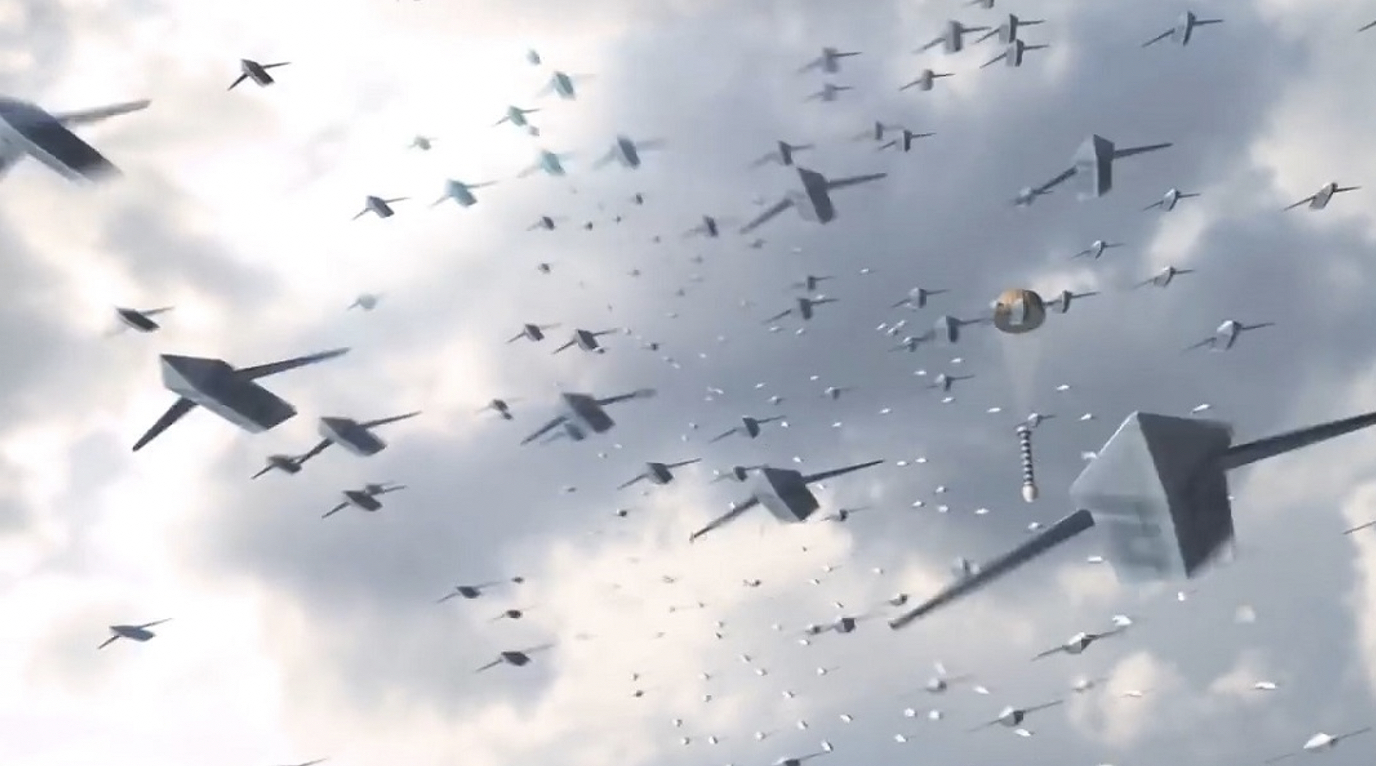
Challenges and Limitations
Regulatory Hurdles
As we navigate through the exciting domain of drone swarms and their numerous applications, it’s crucial to acknowledge the challenges and limitations that accompany this technological advancement. One of the most significant barriers is the regulatory hurdles that drone operators face. Government regulations play a pivotal role in managing how drones can be deployed, especially in swarm formations.
Understanding the Regulatory Landscape
- Complexity of Regulations:
- The regulatory framework concerning drone usage varies from country to country and even from state to state within countries. This inconsistency can cause significant challenges for developers and users of drone swarms. Imagine a company that has innovated a remarkable drone swarm solution for disaster relief—only to discover that its operational capabilities are restricted in certain areas due to local laws.
- Airspace Management:
- Coordinating multiple drones in the same airspace while ensuring safety is no easy task. Regulatory bodies like the Federal Aviation Administration (FAA) in the United States and other global equivalents have stringent air traffic management systems that must be adhered to. These restrictions can indeed hamper deployment, especially in urban environments where airspace is crowded.
- Privacy Concerns:
- Another regulatory issue relates to privacy concerns. The use of drones, particularly those with surveillance capabilities, raises significant questions about user privacy and data protection. Many communities are wary about being monitored by drone swarms, which can potentially capture sensitive footage without consent. Regulators are now faced with the challenge of balancing technological progress with safeguarding individual rights.
- Certification and Standards:
- For many drone applications, especially in critical sectors like healthcare and military operations, certification processes can be lengthy and complex. There are often obligations for manufacturers and operators to demonstrate thorough safety measures and reliability before they can start using swarm technology in the field.
| Regulatory Challenge | Description |
|---|---|
| Complexity of Regulations | Varying laws from country to country |
| Airspace Management | Managing drones in crowded urban environments |
| Privacy Concerns | Safeguarding individual privacy rights |
| Certification and Standards | Lengthy processes for safety and reliability assessments |
The experience of a small start-up attempting to integrate drone swarm technology for agricultural monitoring serves as a poignant example. After developing their innovative system, they found themselves entangled in a web of local regulations, delaying deployment while they worked through necessary permits and community concerns. This not only set back their launch timeline but also strained their financial resources.
Security Concerns
Transitioning from regulatory hurdles, we need to address another pressing issue: security concerns associated with drone swarms. As the capabilities of drone technology advance, so do the risks associated with their misuse. This section takes a closer look at the security challenges that exist when deploying drone swarms.
The Security Landscape for Drone Swarms
- Potential for Malicious Use:
- The use of drone swarms isn’t limited to benevolent applications. The potential for drone swarms to be employed in malicious activities—such as surveillance for criminal purposes or even orchestrating coordinated attacks—poses a significant security risk. For example, imagine a scenario where unauthorized individuals leverage drone swarms for illegal surveillance near critical infrastructure.
- Cybersecurity Threats:
- With drone swarms relying heavily on communication networks and software systems, they are vulnerable to hacking and cyber attacks. If a malicious entity gains access to a drone swarm’s data stream, they could potentially take control of the drones, divert them, or execute unintended missions. Such vulnerabilities prompt developers to prioritize cybersecurity measures alongside hardware and operational capabilities.
- Inaccurate Data and Decision-Making:
- Drones collect and relay invaluable data. However, if the data is manipulated or compromised, it can lead to misinformation and faulty decisions. For instance, consider a disaster response team relying on faulty data provided by compromised drones, which may lead to misallocating resources and failing to address the most critical needs.
- Physical Security of Drones:
- Ensuring the physical security of drones themselves is critical. A swarm of drones left unattended or poorly secured could be hijacked or repurposed for unauthorized use. This concern demands attention not only in military and law enforcement contexts but also in commercial applications.
| Security Concern | Description |
|---|---|
| Potential for Malicious Use | Misuse of drone swarms for criminal activities |
| Cybersecurity Threats | Vulnerabilities to hacking and cyber attacks |
| Inaccurate Data and Decisions | Risks of compromised data leading to misinformation |
| Physical Security of Drones | Ensuring drones are secure from theft or unauthorized use |
Let’s consider a relatable example: during recent events, there have been reports of drone swarms being employed for unauthorized surveillance near private properties and infrastructure, raising alarm bells among lawmakers and local communities. Such instances illustrate the precarious balance between technological advancement and the risk of misuse.
Conclusion
In conclusion, while the promise of drone swarms in various applications—from military operations to disaster relief—is vast and impactful, it’s vital to recognize the challenges and limitations that accompany this burgeoning technology. Regulatory hurdles can delay deployment and create barriers to entry, while security concerns introduce risks that must be mitigated. As we continue to explore and expand the frontier of drone swarm technology, addressing these challenges is paramount. Collaborations among regulators, developers, and communities will be essential in shaping a regulatory framework that not only encourages innovation but also promotes safety and security. With the right balance, the potential of drone swarms can be fully realized while minimizing risks, ultimately enhancing their positive impact on society. 🌍

The Future of Aerial Technology
Innovations in Drone Swarms
As we look towards the horizon of aerial technology, the future of drone swarms appears both promising and exciting. Innovations are happening at a rapid pace, fueled by the convergence of advancements in artificial intelligence (AI), machine learning, and robotics. These developments are setting the stage for a leap in how drone swarms will be utilized across various fields.
- Advanced Coordination Algorithms:
- Future innovations will focus heavily on improving the communication between drones in a swarm. Advanced algorithms will allow drones to adapt rapidly to real-time changes in their environment, enabling them to execute complex tasks more efficiently. Imagine a swarm of drones coordinating seamlessly not just to avoid obstacles but to reallocate tasks based on changing priorities—like a team of dancers performing a routine flawlessly!
- Autonomous Decision-Making:
- As AI technology advances, expect drones to become increasingly autonomous. Instead of relying on a single operator, drones equipped with advanced analytics and decision-making capabilities will be able to assess situations independently. This could be a game changer in emergency situations where every second counts, like during a natural disaster when minute-by-minute decisions can save lives.
- Enhanced Payload Capabilities:
- From carrying medical supplies in emergencies to conducting precision agriculture surveys, the future drones will feature enhanced payload capabilities, allowing them to handle more significant and varied equipment. For example, envision a swarm of drones each carrying sensors capable of measuring air quality, moisture levels, and crop health, delivering valuable data to farmers seamlessly.
- Quantum Technologies:
- Looking even further ahead, research is underway on integrating quantum computing to boost processing capabilities, analyze data faster, and improve security protocols for drone swarms. While this might sound like science fiction, the implications for speed and efficiency in aerial operations could be transformative.
- Cross-Domain Operations:
- Future drone swarms could operate in conjunction with other technologies, such as ground robots or autonomous vehicles, to create robust, multi-faceted operational capabilities. For instance, a swarm of drones working alongside autonomous ground vehicles in a disaster zone could enhance search and rescue efforts significantly.
| Innovation | Description |
|---|---|
| Advanced Coordination Algorithms | Improved algorithms for communication and task allocation among drones |
| Autonomous Decision-Making | Drones capable of making independent assessments in real-time operational scenarios |
| Enhanced Payload Capabilities | Ability to carry larger and more diverse equipment for varied applications |
| Quantum Technologies | Augmentation of processing power for better data analysis and security |
| Cross-Domain Operations | Collaboration with other autonomous systems for comprehensive operational strategies |
Potential Impact on Various Industries
The innovations in drone swarms are set to dramatically impact numerous industries, reshaping them in ways we’re just beginning to imagine. Here’s a closer look at some sectors likely to experience tectonic shifts due to advancements in drone technology:
- Agriculture:
- Precision farming is on the rise, and drone swarms will play a crucial role in this evolution. With enhanced data collection and analysis through swarms, farmers will be able to monitor crop health in real-time, making better decisions regarding fertilizer, pest control, and irrigation. Picture large farms deploying swarms of drones to gather comprehensive data, allowing farmers to optimize yield while minimizing environmental impact.
- Logistics and Delivery:
- As e-commerce continues to grow, drone swarms will revolutionize last-mile delivery. Imagine swarms of drones working collaboratively to deliver packages quickly and efficiently without harming the environment. For instance, the use of swarms could allow urban areas to receive deliveries without congesting road traffic, improving the urban logistic systems.
- Emergency Services:
- Emergency response will transform with the adoption of drone swarms. In addition to assessing disaster areas, these drones can help locate missing persons during search and rescue operations. The immediate aerial support provided by swarms will allow emergency services to allocate resources more effectively, resulting in quicker responses. Reflecting on how search operations were conducted historically, we can appreciate the potential for improved outcomes in life-threatening situations.
- Infrastructure Inspections:
- Infrastructure maintenance, such as bridges, railways, and power lines, will also benefit from drone swarms. Using swarming technology, companies can carry out inspections faster, reducing the risk to human workers and providing real-time data to maintenance teams. Imagine a fleet of drones inspecting an extensive railway system in a fraction of the time it would take traditional teams to do the same.
- Environmental Monitoring:
- The potential for drone swarms to monitor environmental changes, collect data on wildlife, and observe pollution levels is enormous. Swarms can cover vast regions, collecting data that contribute to environmental conservation efforts. In the future, drones could help scientists track animal populations or monitor climate changes more effectively, offering a more rounded understanding of our ecosystems.
| Industry | Impact from Drone Swarms |
|---|---|
| Agriculture | Enhanced data collection for precision farming |
| Logistics and Delivery | Revolutionized last-mile delivery systems |
| Emergency Services | Improved search and rescue capabilities |
| Infrastructure Inspections | Faster, safer evaluations of critical infrastructure projects |
| Environmental Monitoring | Comprehensive data collection for ecosystem health and conservation |
Conclusion
In wrapping up our exploration of the future of aerial technology, it’s clear that innovations in drone swarms are set to revolutionize a multitude of industries, each reaping the benefits of improved efficiency, safety, and data collection. The possibilities are vast, and as technology continues to evolve, so too will the applications and effectiveness of these remarkable aerial fleets. As we anticipate future developments, the transformation of our daily lives through drone technology becomes more tangible, shifting from the realm of possibility into the practical. Whether it’s a farmer optimizing their harvest, a logistics company speeding up deliveries, or environmentalists gathering crucial data, drone swarms could immensely enhance efficiency and effectiveness across the board. With thoughtful innovation and continuous collaboration among experts, regulators, and communities, the future of aerial technology appears bright and full of promise. The impact of drone swarms on our world will not only redefine operational strategies but also develop a greater understanding and stewardship of our environment—all while enhancing everyday life. ✈️🌟
